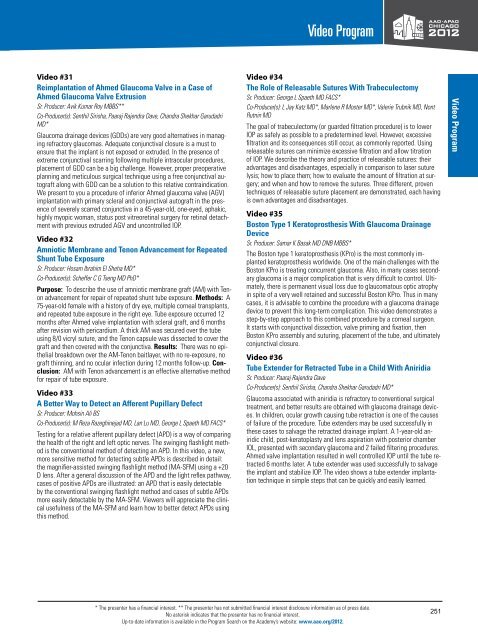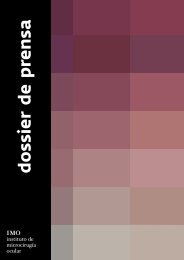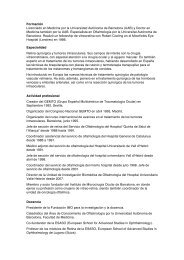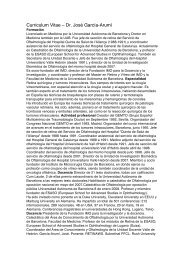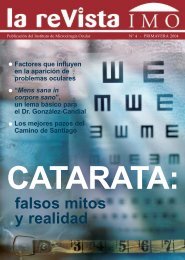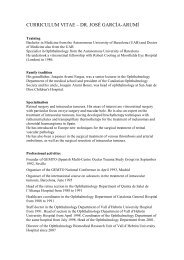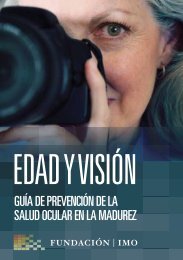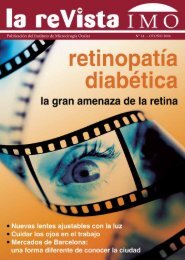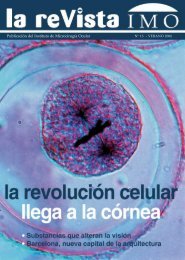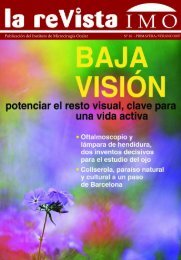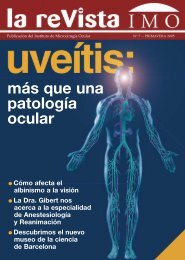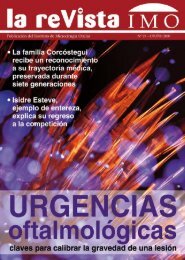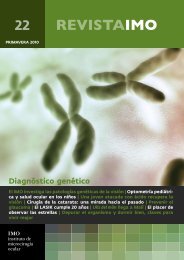FINAL PROGRAM - Imo
FINAL PROGRAM - Imo
FINAL PROGRAM - Imo
You also want an ePaper? Increase the reach of your titles
YUMPU automatically turns print PDFs into web optimized ePapers that Google loves.
Video Program<br />
Video #31<br />
Reimplantation of Ahmed Glaucoma Valve in a Case of<br />
Ahmed Glaucoma Valve Extrusion<br />
Sr. Producer: Avik Kumar Roy MBBS**<br />
Co-Producer(s): Senthil Sirisha, Paaraj Rajendra Dave, Chandra Shekhar Garudadri<br />
MD*<br />
Glaucoma drainage devices (GDDs) are very good alternatives in managing<br />
refractory glaucomas. Adequate conjunctival closure is a must to<br />
ensure that the implant is not exposed or extruded. In the presence of<br />
extreme conjunctival scarring following multiple intraocular procedures,<br />
placement of GDD can be a big challenge. However, proper preoperative<br />
planning and meticulous surgical technique using a free conjunctival autograft<br />
along with GDD can be a solution to this relative contraindication.<br />
We present to you a procedure of inferior Ahmed glaucoma valve (AGV)<br />
implantation with primary scleral and conjunctival autograft in the presence<br />
of severely scarred conjunctiva in a 45-year-old, one-eyed, aphakic,<br />
highly myopic woman, status post vitreoretinal surgery for retinal detachment<br />
with previous extruded AGV and uncontrolled IOP.<br />
Video #32<br />
Amniotic Membrane and Tenon Advancement for Repeated<br />
Shunt Tube Exposure<br />
Sr. Producer: Hosam Ibrahim El Sheha MD*<br />
Co-Producer(s): Scheffer C G Tseng MD PhD*<br />
Purpose: To describe the use of amniotic membrane graft (AM) with Tenon<br />
advancement for repair of repeated shunt tube exposure. Methods: A<br />
75-year-old female with a history of dry eye, multiple corneal transplants,<br />
and repeated tube exposure in the right eye. Tube exposure occurred 12<br />
months after Ahmed valve implantation with scleral graft, and 6 months<br />
after revision with pericardium. A thick AM was secured over the tube<br />
using 8/0 vicryl suture, and the Tenon capsule was dissected to cover the<br />
graft and then covered with the conjunctiva. Results: There was no epithelial<br />
breakdown over the AM-Tenon baitlayer, with no re-exposure, no<br />
graft thinning, and no ocular infection during 12 months follow-up. Conclusion:<br />
AM with Tenon advancement is an effective alternative method<br />
for repair of tube exposure.<br />
Video #33<br />
A Better Way to Detect an Afferent Pupillary Defect<br />
Sr. Producer: Mohsin Ali BS<br />
Co-Producer(s): M Reza Razeghinejad MD, Lan Lu MD, George L Spaeth MD FACS*<br />
Testing for a relative afferent pupillary defect (APD) is a way of comparing<br />
the health of the right and left optic nerves. The swinging flashlight method<br />
is the conventional method of detecting an APD. In this video, a new,<br />
more sensitive method for detecting subtle APDs is described in detail:<br />
the magnifier-assisted swinging flashlight method (MA-SFM) using a +20<br />
D lens. After a general discussion of the APD and the light reflex pathway,<br />
cases of positive APDs are illustrated: an APD that is easily detectable<br />
by the conventional swinging flashlight method and cases of subtle APDs<br />
more easily detectable by the MA-SFM. Viewers will appreciate the clinical<br />
usefulness of the MA-SFM and learn how to better detect APDs using<br />
this method.<br />
Video #34<br />
The Role of Releasable Sutures With Trabeculectomy<br />
Sr. Producer: George L Spaeth MD FACS*<br />
Co-Producer(s): L Jay Katz MD*, Marlene R Moster MD*, Valerie Trubnik MD, Nont<br />
Rutnin MD<br />
The goal of trabeculectomy (or guarded filtration procedure) is to lower<br />
IOP as safely as possible to a predetermined level. However, excessive<br />
filtration and its consequences still occur, as commonly reported. Using<br />
releasable sutures can minimize excessive filtration and allow titration<br />
of IOP. We describe the theory and practice of releasable sutures: their<br />
advantages and disadvantages, especially in comparison to laser suture<br />
lysis; how to place them; how to evaluate the amount of filtration at surgery;<br />
and when and how to remove the sutures. Three different, proven<br />
techniques of releasable suture placement are demonstrated, each having<br />
is own advantages and disadvantages.<br />
Video #35<br />
Boston Type 1 Keratoprosthesis With Glaucoma Drainage<br />
Device<br />
Sr. Producer: Samar K Basak MD DNB MBBS*<br />
The Boston type 1 keratoprosthesis (KPro) is the most commonly implanted<br />
keratoprosthesis worldwide. One of the main challenges with the<br />
Boston KPro is treating concurrent glaucoma. Also, in many cases secondary<br />
glaucoma is a major complication that is very difficult to control. Ultimately,<br />
there is permanent visual loss due to glaucomatous optic atrophy<br />
in spite of a very well retained and successful Boston KPro. Thus in many<br />
cases, it is advisable to combine the procedure with a glaucoma drainage<br />
device to prevent this long-term complication. This video demonstrates a<br />
step-by-step approach to this combined procedure by a corneal surgeon.<br />
It starts with conjunctival dissection, valve priming and fixation, then<br />
Boston KPro assembly and suturing, placement of the tube, and ultimately<br />
conjunctival closure.<br />
Video #36<br />
Tube Extender for Retracted Tube in a Child With Aniridia<br />
Sr. Producer: Paaraj Rajendra Dave<br />
Co-Producer(s): Senthil Sirisha, Chandra Shekhar Garudadri MD*<br />
Glaucoma associated with aniridia is refractory to conventional surgical<br />
treatment, and better results are obtained with glaucoma drainage devices.<br />
In children, ocular growth causing tube retraction is one of the causes<br />
of failure of the procedure. Tube extenders may be used successfully in<br />
these cases to salvage the retracted drainage implant. A 1-year-old aniridic<br />
child, post-keratoplasty and lens aspiration with posterior chamber<br />
IOL, presented with secondary glaucoma and 2 failed filtering procedures.<br />
Ahmed valve implantation resulted in well controlled IOP until the tube retracted<br />
6 months later. A tube extender was used successfully to salvage<br />
the implant and stabilize IOP. The video shows a tube extender implantation<br />
technique in simple steps that can be quickly and easily learned.<br />
Video Program<br />
* The presenter has a financial interest. ** The presenter has not submitted financial interest disclosure information as of press date.<br />
No asterisk indicates that the presenter has no financial interest.<br />
Up-to-date information is available in the Program Search on the Academy’s website: www.aao.org/2012.<br />
251


